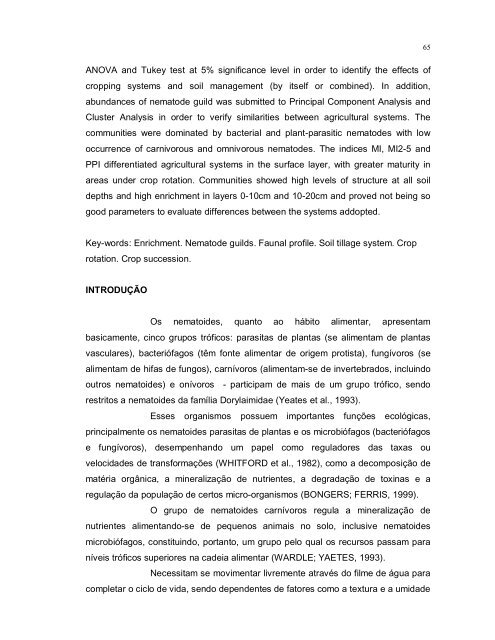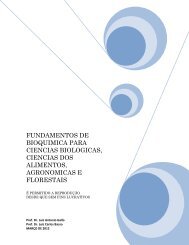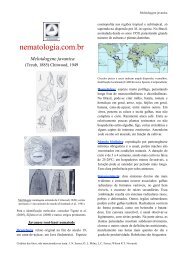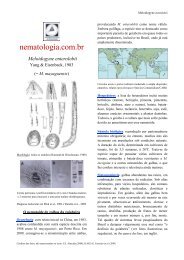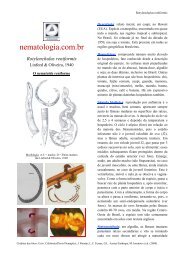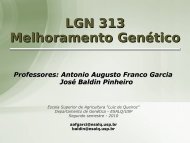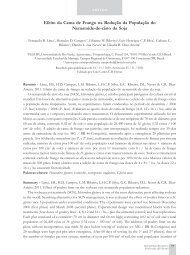diversidade de nematoides em sistemas de culturas e ... - Index of
diversidade de nematoides em sistemas de culturas e ... - Index of
diversidade de nematoides em sistemas de culturas e ... - Index of
Create successful ePaper yourself
Turn your PDF publications into a flip-book with our unique Google optimized e-Paper software.
65ANOVA and Tukey test at 5% significance level in or<strong>de</strong>r to i<strong>de</strong>ntify the effects <strong>of</strong>cropping syst<strong>em</strong>s and soil manag<strong>em</strong>ent (by itself or combined). In addition,abundances <strong>of</strong> n<strong>em</strong>ato<strong>de</strong> guild was submitted to Principal Component Analysis andCluster Analysis in or<strong>de</strong>r to verify similarities between agricultural syst<strong>em</strong>s. Thecommunities were dominated by bacterial and plant-parasitic n<strong>em</strong>ato<strong>de</strong>s with lowoccurrence <strong>of</strong> carnivorous and omnivorous n<strong>em</strong>ato<strong>de</strong>s. The indices MI, MI2-5 andPPI differentiated agricultural syst<strong>em</strong>s in the surface layer, with greater maturity inareas un<strong>de</strong>r crop rotation. Communities showed high levels <strong>of</strong> structure at all soil<strong>de</strong>pths and high enrichment in layers 0-10cm and 10-20cm and proved not being sogood parameters to evaluate differences between the syst<strong>em</strong>s addopted.Key-words: Enrichment. N<strong>em</strong>ato<strong>de</strong> guilds. Faunal pr<strong>of</strong>ile. Soil tillage syst<strong>em</strong>. Croprotation. Crop succession.INTRODUÇÃOOs n<strong>em</strong>atoi<strong>de</strong>s, quanto ao hábito alimentar, apresentambasicamente, cinco grupos tróficos: parasitas <strong>de</strong> plantas (se alimentam <strong>de</strong> plantasvasculares), bacteriófagos (têm fonte alimentar <strong>de</strong> orig<strong>em</strong> protista), fungívoros (sealimentam <strong>de</strong> hifas <strong>de</strong> fungos), carnívoros (alimentam-se <strong>de</strong> invertebrados, incluindooutros n<strong>em</strong>atoi<strong>de</strong>s) e onívoros - participam <strong>de</strong> mais <strong>de</strong> um grupo trófico, sendorestritos a n<strong>em</strong>atoi<strong>de</strong>s da família Dorylaimidae (Yeates et al., 1993).Esses organismos possu<strong>em</strong> importantes funções ecológicas,principalmente os n<strong>em</strong>atoi<strong>de</strong>s parasitas <strong>de</strong> plantas e os microbiófagos (bacteriófagose fungívoros), <strong>de</strong>s<strong>em</strong>penhando um papel como reguladores das taxas ouvelocida<strong>de</strong>s <strong>de</strong> transformações (WHITFORD et al., 1982), como a <strong>de</strong>composição <strong>de</strong>matéria orgânica, a mineralização <strong>de</strong> nutrientes, a <strong>de</strong>gradação <strong>de</strong> toxinas e aregulação da população <strong>de</strong> certos micro-organismos (BONGERS; FERRIS, 1999).O grupo <strong>de</strong> n<strong>em</strong>atoi<strong>de</strong>s carnívoros regula a mineralização <strong>de</strong>nutrientes alimentando-se <strong>de</strong> pequenos animais no solo, inclusive n<strong>em</strong>atoi<strong>de</strong>smicrobiófagos, constituindo, portanto, um grupo pelo qual os recursos passam paraníveis tróficos superiores na ca<strong>de</strong>ia alimentar (WARDLE; YAETES, 1993).Necessitam se movimentar livr<strong>em</strong>ente através do filme <strong>de</strong> água paracompletar o ciclo <strong>de</strong> vida, sendo <strong>de</strong>pen<strong>de</strong>ntes <strong>de</strong> fatores como a textura e a umida<strong>de</strong>


